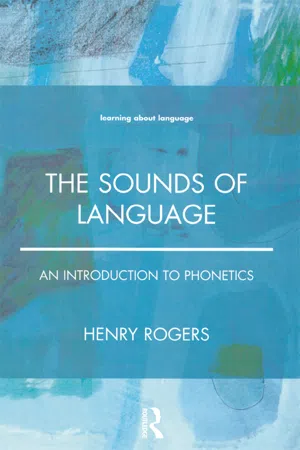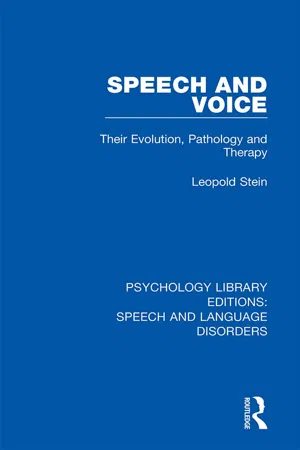Interdental
Interdental refers to sounds produced by placing the tongue between the teeth, such as the "th" sound in English words like "this" and "think." These sounds are created by airflow between the tongue and the upper teeth or the lower teeth. In phonetics, interdental sounds are classified as a type of dental consonant.
4 Key excerpts on "Interdental"
- eBook - ePub
The Sounds of Language
An Introduction to Phonetics
- Henry Rogers(Author)
- 2014(Publication Date)
- Routledge(Publisher)
...High tone here is shown by [´] and low tone by [`]. Ewe Labiodental The lower lip articulates against the upper teeth to form labiodental consonants (Figure 10.1). Labiodental stops do not occur distinctively although they are quite easy to make if your teeth do not have gaps. The labiodental nasal [m] is reported in Teke (Laver, 1994). It occurs allophonically in English words like symphony where it is a homorganic nasal agreeing as to place of articulation with the following labiodental fricative [f] or [v]. As noted in the preceding section on bilabials, languages commonly have bilabial stops and labiodental fricatives. The transition next to a labiodental consonant points down as with the bilabials (Figure 10.2). The fricatives have fairly faint noise. Figure 10.2 Spectrograms of bilabial and labiodental stops and fricatives Linguo-labial Maddieson (1989) reports a very rare linguo-labial sound with the tip or blade of the tongue articulating with the upper lip. The IPA uses a gull-shaped diacritic for this place of articulation. Venen Taut (Austronesian, Vanuatu) Coronal Coronal sounds are made with the apex or lamina of the tongue. They include dentals, alveolars, alveolo-palatals, postalveolars, and retroflex sounds. Dental Dental sounds can be made with either the tip of the tongue, apico-dental, or with the blade, laminodental. The dental fricatives are voiceless [θ] theta and voiced eth. Other dental sounds are shown by using the alveolar symbol with the diacritic for example. Because in a given language all the stops are usually all dental or all alveolar, you will find that in discussing a particular language, the diacritic is commonly omitted with the assumption that you will know whether [t d n] represent dentals or alveolars. Dental fricatives with the blade of the tongue near the back of the upper teeth, can be made in addition to the dentals. Interdentals are made by thrusting the tongue slightly forward so that the tip protrudes between the teeth...
- David Hornsby(Author)
- 2014(Publication Date)
- Teach Yourself(Publisher)
...These sounds are therefore bilabial. By contrast, for [t] and [d] the tongue touches the back of the teeth and the alveolar ridge to produce a dental-alveolar sound, while contact between tongue and soft palate produces the velar sounds [k] and [ g ]. Other English consonants are labio-dental (bringing bottom lip and top teeth together), palatal (the tongue meets the hard palate), alveolar-palatal (closure is made at the point where hard palate and alveolar ridge meet) or glottal (involving full or partial closure of the glottis). The full set of English consonants, with examples, is shown on the next page: Figure 4.1: The consonants of English The final parameter for the description of consonants is manner of articulation, of which five kinds are relevant to English. When you produced [p] and [b] earlier, you felt a build-up of air pressure behind your lips, which was suddenly released to produce the sound. Similarly, the consonants [t, d, k, g] are produced by releasing pressure behind the tongue. Sounds like these are called plosives. Plosives are literally small explosions in the vocal tract, and therefore cannot be extended. They are very different, therefore, from the [f] and [v] sounds in f i v e, which you can extend for as long as you have enough breath. For these sounds, the airstream passes through the articulators to produce audible friction, hence the name fricatives. As was the case for the plosives, the fricatives come in voiceless/voiced pairs: [f] and [v] are voiceless and voiced labio-dental fricatives respectively; the other English fricative pairs shown in the diagram above are [, Ʒ ] [ s, z ] and [ θ, ð ]. Some consonants, known as affricates, combine a plosive and a fricative at the same place of articulation, as in the case of [ t ] and [ d Ʒ ] in English. The plosive sounds we identified earlier involve a complete closure of the vocal tract: they are, in other words, kinds of stop consonants...
- eBook - ePub
Speech and Voice
Their Evolution, Pathology and Therapy
- Leopold Stein(Author)
- 2018(Publication Date)
- Routledge(Publisher)
...if [k] is replaced by [t], it has been the custom to indicate this in the diagnostic term by the prefix ‘para’ (para, ‘beside’), Parakappacism, and so on. Multiple Interdentalism. —Multiple Interdentalism (Fröschels) 1 may prove a suitable introduction to this subject. This disorder is, as it were, a transition from Universal Dyslalia to Partial Dyslalia. It affects more or less all sounds articulated by the tip of the tongue, such as [s], [t], [d], [n], [l], [∫]; [ϑ] and [δ] are naturally also affected, unless we admit that their proper articulation is Interdental, a misconception often found in German books. “The letter TH represents two standard English sounds. The one, whose phonetic symbol is ϑ, a breathed dental fricative, articulated by the tip of the tongue against the upper teeth, the main part of the tongue being more or less flat. The symbol δ stands for the voiced form of ϑ.” 2 In Multiple Interdentalism all or some of the aforementioned speech-sounds are articulated Interdentally, that is to say, the necessary shape of mouth is altered by putting the tip of the tongue between the front teeth. Evolutionary Explanation — Multiple Interdentalism as such has only recently been clearly recognised, because acoustically the Interdental articulation of [t, d, 1, n] is scarcely noticeable. Only the Interdental pronunciation of the sibilants [s, z, ∫, ʒ] strikes the ear. In Multiple Interdentalism a uniform tendency to protrude the tip of the tongue in all tongue-tip sounds is obvious. Now the,view that all sounds are the outcome of the integration of vegetative motor tendencies brings to mind the fact that the protrusion of the tongue is a common behaviour of babies. Analytical and developmental considerations seem to suggest that it is associated with sucking movements. The tongue may thus ultimately represent the nipple, and manifest a primitive libidinal tendency. The protrusion of the tongue is frequent in mental defectives...
- eBook - ePub
English Phonetics and Phonology
An Introduction
- Philip Carr(Author)
- 2019(Publication Date)
- Wiley-Blackwell(Publisher)
...Such processes involve a principle of ease of articulation. In this case, if the nasal in pamphlet is articulated at the same place as the following fricative, this saves the speaker the articulatory effort of moving from a bilabial to a labio‐dental articulation. We will return to such processes in Chapter 6. Dental nasal stops (transcribed as [n̪]) entail complete closure between the tip of the tongue and the upper teeth, voicing, and escape of the air through the nasal cavity. An example is the second consonant in tenth. As in this case, they occur before other dental sounds, and this too is a matter of assimilation involving place of articulation. Alveolar nasal stops (transcribed as [n]) entail complete closure between the blade of the tongue and the alveolar ridge, voicing, and escape of the air through the nasal cavity. An example is the first sound in not. Velar nasal stops (transcribed as [ŋ]) entail complete closure between the back of the tongue and the velum, voicing, and escape of the air through the nasal cavity. An example is the last sound in sing or the nasal stop as it is often articulated (especially in faster or more casual speech styles) in the word incredible. Once again, the latter case involves assimilation. Exercises Listen to Track 2.1 at www.wiley.com/go/carrphonetics. For each of the words on the recording, identify (a) any oral stops, (b) any fricatives, (c) any approximants, (d) any affricates and (e) any nasals. For each sound that you identify, say whether it is voiced or voiceless and what its place of articulation is (e.g. the word stop : voiceless alveolar stop [t] and voiceless bilabial stop [p]; voiceless alveolar fricative [s]; no approximants, affricates or nasals). The words are: bring licking fever thinking assure measure heated years worm jungle Listen to Track 2.2...



